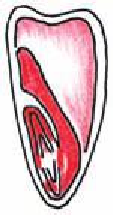Agriculture Reference
In-Depth Information
TETrAzoLIuM METHodS for VArIouS rEPrESEnTATIVE fAMILIES
The following represents preparation, staining and evaluation methods for tetrazolium testing of several
familiar species. Information for each genus or kind of seed was taken from both the text and Table 1 of the
ISTA Handbook on Tetrazolium Testing (1985) and ISTA Working Sheets on Tetrazolium Testing (2003).
These examples represent the groups of seeds that analysts in most laboratories are likely to test. Use of
these examples, plus the information given for general procedures presented earlier, should enable the
experienced analyst to be able to test almost any species. Although this may require careful study of the
comparative anatomy of seed structures along with close attention to proper procedure and detail, it should
result in success for the analyst who perseveres. All illustrations were sketched by Sabry Elias.
Poaceae
Example:
Zea mays
- large-sized cereal grain
1. Moistening: Soak in water 18 hr.
2. Preparation after moistening:
a. Cut the seeds longitudinally almost full depth through the midsection. Then spread the cut
surfaces slightly apart. In some cases, analysts discard one-half and keep one-half of the seed
for evaluation to have exactly 100 seeds in each replication
3. Staining time: 6-24 hr (at room temperature) or 2-4 hr at 35-38°C. Usually no cutting is required
after staining.
4. Preparation for evaluation: Expose the embryo and the adjoining nutritive tissue by spreading the
cut surfaces suficiently to expose the desired tissue.
5. Evaluation of viable seed:
a. Embryo completely stained. If radicle is not stained, no root system will develop.
b. Embryo completely stained except for necrosis on no more than 1/3 of upper and lower ends
of the scutellum.
c. Embryo completely stained except for necrosis on distal 1/4 of plumule.
d. Embryo completely stained except for necrosis on distal 1/2 of coleoptile.
Poaceae
Zea mays
(Corn)
(1)
(1)
(2)
(2)
Non-Viable Seed
Viable Seed
(1) Embryo is completely stained, and (2)
less than 1/3 of the scutellum is unstained.
(1) Plumule is not completely stained, and
(2) radicle is not completely stained.




